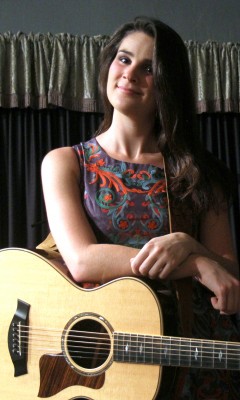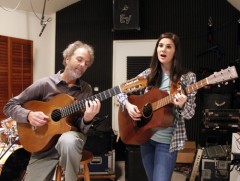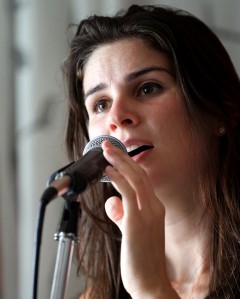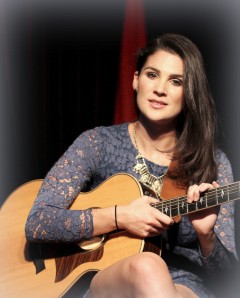Cover Story
Nina Francis: A New Girl in the Garden
“Right now my plan is to gig like a maniac,” says Nina Francis. She smiles, but the determined look in her eye lets me know that she is not joking in the slightest.
Francis and I are sitting at one of those cozy tables at Mystic Mocha, the University Heights coffeehouse known for being unusually funky and unusually clean at the same time. It’s a sunny morning. Francis’ long brown hair frames her face.
“Gig like a maniac?” I ask.
“Yeah, like this week I’ve got a four-hour gig.”
“Is there anybody performing with you?”
“No. Just me.”
“Four hours by yourself?”
“Yeah.”
She seems to think that performing solo for four hours is not a big deal. But put yourself in that situation. Yes, even you veteran performers, could any of you hold up performing by yourself for that length of time? Could you trumpeters blow your trumpet for four hours? How about you bassoonists? How would you feel after playing your bassoon for four hours? Maybe Francis is right; maybe she is gigging like a maniac.
Nina Francis is tall; she is also pretty. Her eyes are mahogany brown. Today she is wearing large hoop earrings and a sleeveless black top. She speaks slowly and leans forward a bit, like a tutor working with a student.
Francis is a singer/songwriter in her early twenties, but to describe her as a “new and up-and-coming performer” would be, well, wrong. Despite her youth, she has been writing and singing her songs, and working at her craft for the last ten years. She has also received the mentorship of some of the best musicians and songwriters in the country. If she’s not on your musical radar, she should be.
The singer/songwriter has had recent appearances at 98 bottles, the Adams Avenue Street Fair, Croce’s Park West, and other local venues. In 2014 she released a three-song EP. This past February she released a single, “Boomerang,” which she recorded with FEiN, the Los Angeles-based band known for their big sound. “The guys in FEiN, we all went to USC together. They approached me for a collaboration, and it was great working with them,” she says.
As a singer, if anything, Francis is versatile. Her songs can be soft and intimate, making you feel as though you’re the only one who is hearing her shared secret. Her voice has a lightness and clarity. There is also a warmth to her sound. The San Diego native has been compared to Norah Jones, but Francis is quick to add that she’s a Norah Jones who can rock out from time to time. When the subject of Joni Mitchell comes up, Francis swoons. Indeed, while the young singer does not stretch and shrink lines the way the Canadian singer does, Francis does play with the phrasing of her lyrics. She says, “I want singing that is unmistakably me. You might call it jazzily folk.” She is often found singing with her guitar, and she is a fingerpicker to make any acolyte of Elizabeth Cotton jealous.
The power of pop songs is what drew Francis to them. She appreciates how they can tell a story or pack a lot of emotion into three or four minutes. She works consistently at her craft, always trying to keep producing new tunes, even taking notes on her iPhone as she chances across ideas for songs or lyrics throughout her day. “But there are times when I’ve got nothing,” she confesses.
For her songwriting, there might be the songs we might call Nina Francis version A and Nina Francis version B. Version A is the Francis of a few years ago; the songs she composed during this period are what she considers her “poor me” songs. Nina Francis version B songs are more upbeat. The subject matter may be the same as the Nina Francis songs revision A–a broken heart, a romantic breakup, or other bumps in the road of life–but the themes are more constructive. “I just like myself better as a person now,” she says. “My songs are now more about growth. Typical of my songs now is: ‘This is what I’ve learned from my experience.’”
As far as her compositional style, the music of her songs, Francis likes to mix things up. “I like to have a variety of things going on,” she says. “Other people tell me that I might be a folk jazz person. I like songs with a good hook and a good chorus.”
She performs a few covers, mostly when she is singing in a restaurant or café; otherwise, her repertoire consists of the songs she has penned. Francis does admit that performing covers can be beneficial, because she can see how somebody else uses chords differently or it gives her a chance to examine other songwriters’ lyrics more closely.
Though she is working in a field in which singers and performers can get very famous very fast, Francis thinks that life might be better, and her songwriting might be better, even though she is not rubbing elbows with George Clooney and Lady Gaga. “I think that you need a lot of life experiences,” she says. Fame in general is something for which she is has some reluctance to pursue. “Think about it. Taylor Swift can’t even go to the grocery store!”
After I get a refill on my cup of coffee, I ask Francis about the songs she has written most recently.
“I’ve written 30 songs in the last month,” she says.
“Thirty songs?”
“Yes, 30 songs.
“That’s a lot!”
“They just came to me.”
“Well, what could be the inspiration for this great musical output?”
“Boys!”
I note that Francis’s eyes light up when she says this. She explained that her love life over the last several months had been a bit topsy-turvy. As writers think that there are no bad experiences, only material, the same holds for songwriters. Giving me a brief thumbnail sketch of what she had been through lately, it seemed like she had hit the mother lode of material for lots of pop songs: boy meets girl; boy is unavailable for girl; girl and boy breakup; girl learns from experiences; girl writes lots of songs.
Her family was not a particularly musical family, but she describes her father, a doctor by profession, as being “guitar crazy,” someone who could always find the excuse to buy another guitar and who played almost constantly in his free time. Francis recalls that her mother, to get a little break from the sounds of her husband picking and strumming, spurred him to buy a “silent” guitar, one without a body, for him to play while the rest of the family could spend time around the house in peace.
“My folks are great,” says Francis. “They didn’t really restrict or really try to direct what I wanted to learn. They let me explore a bunch of different options.” The young Francis has tried her hand at art, making animation, and other interests. The spark for her music and creativity came from outside her family. She says, “When I was 11 or 12 my best friend started taking guitar lessons. So I took lessons, too. And I really liked it!”
About as soon as she learned how to make those initial G, C, and D chords, Francis started writing songs. She remembers that her first song was a song about a breakup, possibly inspired by her guitar-playing friend moving away.
Francis attended the Bishop’s School. The college-prep middle school and high school in La Jolla had a regular performance venue that the school called its “coffeehouse.” In ninth grade she performed one of her songs at the venue and received a standing ovation. She says, “I remember thinking, ‘This is the best feeling ever!’”
Not long afterward, Peter Sprague heard Francis sing with the Bishops’ School jazz band and asked her to gig with him. She performed with him at Christmas in Del Mar and opened for him at a few shows.
The Encinitas resident and jazz guitar master saw that the high schooler had a great deal of talent and mentored her. Francis says that Sprague helped to seal the deal for her future career choice. “Peter taught me a lot. He would also challenge me,” she says. But just as important, Francis saw, through Sprague, that a life in music could be a rewarding one. And just because you may be a musician, you don’t have to starve. “Peter gave me the courage to pursue this path,” she says.
The Bishop’s School is well known for its high standards, and there is obvious pressure for the students to apply to Ivy League schools. The La Jolla school has been ranked as one of the top 40 schools in the country to send graduates to Harvard, MIT, and Johns Hopkins. But Francis bucked this trend by going off to the University of Southern California.
College students can go to a conservatory for classical music or major at one of the many jazz studies programs at colleges and universities across the country, but Francis chose USC because it is the only college or university to offer a degree in popular music. The popular music program at USC’s Thornton School of Music covers all the aspects of being a popular performer: songwriting, performance skills, even the part about actually making a living as a musician, such as getting the gigs, making the recording contracts, and even using new things like using YouTube as a promotional tool. “The program was great because, being in Los Angeles, you’re at the center of things for music,” Francis says.
Among the musical luminaries who were available for Francis to study with were Patrice Rushen, the multi-instrumentalist, composer, songwriter, and record producer, and songwriter and record producer Lamont Dozier. She was also mentored by Glen Ballard. The Mississippi-born lyricist, songwriter, and producer is known for his work with the Michael Jackson, the Pointer Sisters, and Dave Mathews Band.
Among the guest instructors/lecturers was Randy Newman, who lectured for a songwriting class. Francis chuckles as she recalls that the composer of film scores, musical theatre, and the man who gave us such hits as “I Love LA” and “It’s Money That I Love” complained that he didn’t care for the open ended aspect of songwriting, saying that he needed structure and deadlines.
In case you were wondering, yes, there are musical geniuses like Paul McCartney who roll out of bed, walk over to the piano, and instantly compose a song like “Yesterday.” For the other 98.7 percent of songwriters it is something they have to work at. And there is a craft to it, which Francis studied at USC. “The first couple of weeks we were learning the basics,” she says. “They would explain: ‘This is a verse. This is a chorus. The verse gives details. The chorus is the big statement.’”
And the songwriting classes also taught the students the power of rewriting, editing, and taking a critical eye to their own work. Francis says, “Now I can look at one of my songs and think: ‘Is this good?’ They give you the ability to go back and work on a song. You just don’t sit there and think, ‘I’m done. It’s a masterpiece!’”
The faculty also pushed and challenged the students. In one instance, all of the songwriting students were tasked with writing a song in an hour or under. They would also form the students into bands and ensembles, throwing them into groups where they may or may not know the other students or, even more challenging, put students who did not get along well in the same ensemble. Francis thinks that this was a good experience to go through, because all these experiences are part of being in a band.
At USC Francis studied voice with Jeffrey Allen, who has been teaching singers and singing for the last 40 years. She says, “He is absolutely the best! As a student, you learn very quickly in just a few lessons. He shows you why your voice cracks and how to easily get different levels of volume and intensity.”
During her student days, Francis was part of USC’s Thornton Songwriter Showcase at the Grammy Museum in Downtown Los Angeles. She also had the privilege of taking part in a study abroad program that gave her the chance to perform for several well-received shows in a tour around London, England.
She graduated two years ago, returning to San Diego. After living in Los Angeles, Francis notes the differences of the music scene in LA and America’s Finest City, saying, “Here it’s real grassroots and friendly.” She also notes that there is a spirit of cooperation in San Diego, where musicians help each other and enjoy seeing their peers succeed. “In Los Angeles it is about how many plays your song gets.”
Francis is in the process of putting together the material for an album, writing about ten songs. Another recent development is that she has picked up an electric guitar a few times and found that she likes it. Don’t be surprised if there is a more electric sound in her songs in the near future. She is also resurrecting her “First Friday” videos on her YouTube channel, in which she releases a video of a cover song on the first Friday of every month.
“But right now you’re gigging like a maniac,” I say.
“Right. Gigging like a manic.”
“How about the future?”
“My hopes are high,” she says. “I think I might want to try to become a national act. I really want my music to reach more people.”
THE SINGER/SONGWRITER TRADITION
As a singer/songwriter, Nina Francis participates in a tradition that goes back generations. Mostly confined to the folk tradition, there were a few individuals in the 1930s to both write and sing their songs. Most famously, Huddie Ledbetter (more commonly known as Lead Belly) and Woody Guthrie gave us such classics as “The Midnight Special,” “Goodnight Irene,” “Frog Went A-courtin’,” and “This Land Is Your Land.”
In popular music there remained a demarcation between songwriter and singer. Folks like Cole Porter, Jimmy Van Heusen, and Hoagy Carmichael wrote the songs; folks like Frank Sinatra and Ella Fitzgerald sang the songs. Performers such as Johnny Mercer, who wrote and sang his songs, remained something of an outlier.
In the sixties bands like the Beatles wrote a great deal of their own songs, but the first instance of someone being called a singer/songwriter that I could find was in the New York Times in 1967 when the paper published a story on the then young performer Tim Buckley.
By the early seventies performers such as James Taylor, Laura Nero, and Joni Mitchell cemented the idea of a performer being a singer/songwriter. During that time the label mostly referred to performers who fell into or were influenced by the folk tradition and whose songs were characterized by political protest, social commentary, introspection, and lots of acoustic guitars.
Over the decades, the term has become slightly generalized to mean anyone who writes the songs that he or she sings. A recent ProQuest search on the term lead to an article that referred to Billy Joel as a singer/songwriter. Nonetheless almost all the other performers found on this search could somehow fit that James Taylor/Joni Mitchell paradigm in some way.
NINA’S CALENDAR OF EVENTS
Lazy Hummingbird Lazy Sunday Sessions w/ Justin Werner, April 3, 11am-1pm, 4876 Santa Monica Ave. Free. All ages.
The Rook Bar w/ Andrew Barrack, April 8, 8pm, 7745 University Ave., La Mesa. Free. 21 and up
710 Beach Club, April 12, 9:30pm, 710 Garnet Ave. Free. 21 and up.
Kensington Café, 3rd Sat. of the month, 7-9pm, 4141 Adams Ave., 7-9pm. Free. All ages.
ArtWalk Little Italy, April 30, 3:30pm, India & Cedar Sts. Free. All ages.
Adams Avenue Unplugged (Lestat’s Stage), May 1, 1pm, 3343 Adams Ave. Free. All ages.











